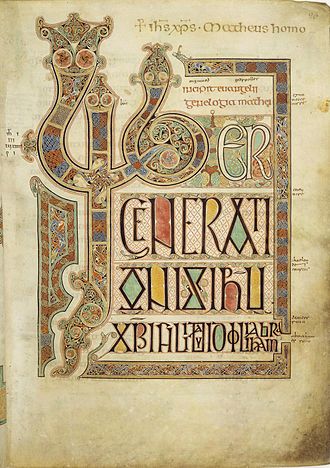by Carol McGrath
During the Anglo-Saxon era the interiors of churches would have glowed with colour, and the walls of the halls were painted with decorative scenes from the imagination telling stories of monsters and heroes like those in the poem Beowulf. Although nothing much is left of the wall paintings, we can discover evidence of their pictorial art in Bibles and Psalters. Monasteries gave religious artists the stability they needed to advance a native style in illuminated manuscripts which was to become the envy of Europe. Much beautiful work was produced by monks in their scriptoriums.
| Outlines of Angels painted above this arch. Early English art above a Norman arch |
This early beautiful illumination work is apparent in the Lindisfarne Gospels of the 7th century. These show a mixture of Byzantine influence and a very lively distinctive English style. The colours and the lines used are fabulous.
 |
| Illustration from the Lindisfarne Gospels |
The golden age of early Anglo-Saxon art came with the period of King Alfred (871-970). There was a resurgence of learning in Wessex, and King Alfred himself translated tracts from the Bible into English. Illuminated texts that were contained beautiful, sophisticated illustrations alive with much symbolism. What follows is just an outline of a few of the symbols to be found in religious manuscripts..
- Man, Angel, lion, bull or calf. These feature in gospel books either alone or accompanying representations of the evangelists in human form. They emerge from the description of God's throne in the Apocalypse. Each gospel is associated with its related symbol.
 |
| John the Evangelist ( Lindesfarne Gospels) |
The Trinity cannot be depicted as it is without form, so only through metaphors and symbols and analogies can the notion be represented. The symbols are often inclusive of the lamb and the dove. Since there are many references to God's right hand in the Old Testament we have Dextera Dei to represent God. The lamb is a reference to Christ with origins in the notion of the Passover lamb in John the Baptist's words 'Look there is the lamb of God that takes away the sin of the world.' The Dove appeared at Christ's baptism in Matt iii.16. The Dove and lamb appear in symbolic images of the Trinity and in scenes such as the Cruxificion placed above the head of Christ to symbolise God's approval of Christ's sacrifice.
Evangelists are portrayed holding books just as St Peter holds keys. Martyred saints hold palm branches and Mary is shown holding the Christ child to indicate her role as mother of the saviour.
| Anglo-Saxon psalter from 11thC |
Angels are very significant in Anglo-Saxon paintings and sculpture. They are placed above canon tables in gospel books often with sceptres as a sign of Christ's royal status. They blow trumpets and hold scales in reference to the coming of judgement. Other motifs vary. For example in a crucifixion scene, Christ may be depicted wearing a diadem and the symbols of the sun and moon are occasionally placed above the arms of the cross to remind the viewer of the darkness that covered the earth at Christ's death and to remind us of the belief that the world mourned the death of its creator.
As a writer of fiction set in this period I find that looking closely at the art and embroidery from this period helps me to come closer to grasping the mind set of the characters in my novels. Equally, it is interesting to recognise how brilliant and talented our early medieval ancestors were when they produced such painstakingly beautiful works of art.
~~~~~~~~~~~~
Carol McGrath is the author of The Handfasted Wife, published by Accent Press, first in a trilogy, Daughters of Hastings. It can be purchased for all e readers and from Amazon UK and USA for kindle and as a paperback.

.jpg)
No comments:
Post a Comment
Note: Only a member of this blog may post a comment.